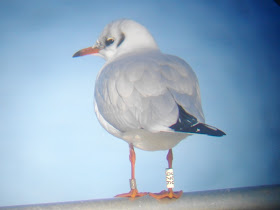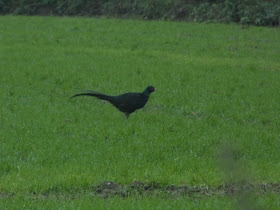For the past couple of years I have set myself a list of target species. Typically these are showy or unusual species, or species from my favoured groups that I have never seen (or seen badly/not photographed). So this year in addition to spending time at Whitlingham & Thorpe (about 30 species to go before I hit the 1000 species mark across all groups), visiting some new reserves and attending a few training workshops to improve my knowledge of different wildlife, I have also put together a list of wildlife that I will attempt to see at some point in 2016..
Mammals
1) I’ve been ‘stuck’ on seven species of bat for a bit now,
Serotine or Barbastelle are the two most likely candidates for my eighth.
2) Having done very little seawatching this year (about 30 minutes worth!) I am still to see an unequivocable
Harbour Porpoise, so that stays on the target list.
Reptiles
3) Last year I found out that there is a small population of
Wall Lizards established at the Spa Gardens in Felixstowe. There was a lot of work done there in 2015, although the contractors were aware of the lizards so were meant to make sure they weren’t affected. I would like to go and have a look for them over the summer.
Amphibians
4) In 2014 I looked unsuccessfully for
Marsh or Edible frogs in Norfolk, so I might try a few sites again this year. I haven’t seen Pool Frog either, but I’m not sure about the ‘arc’ site and the relocation site at Thompson has no public access.
Butterflies
5)
Purple Emperor – We’ll be heading to Northamptonshire to look for these in early summer.
6) I’d like to see at least
one more butterfly species. Having seen all of the Norfolk species, one of the next closest species is Black Hairstreak (Cambridgeshire), although a trip further afield to see Marsh Fritillary in Lincolnshire, Brown Hairstreak in Lincs or Duke of Burgundy & Small Blue in the Chilterns may be possible.
Moths
7)
Hornet Moth –This one has been on the target list for a while. In 2015 I saw some emergence holes in trees at Thorpe St Andrews, but I’m not sure how recent they are.
8)
Lappet – These have been seen on the last two Holme NOA moth days, so I think we will try to attend that this year.
Dragonflies & damselflies
9) I think the closest new odonate to Norfolk would probably be
White-legged Damselfly in south Suffolk or Cambridgeshire. I still haven’t seen Beautiful Demoiselle, does anyone know where the closest population of them to Norfolk are?
Grasshoppers & Crickets
10) Again I’ve seen the Norfolk species so Suffolk seems the best bet, with either
Grey Bush-cricket on coastal shingle or
Woodland Grasshopper near Westleton. Both might take some searching though, so it remains to be seen whether I’ll see a new orthopteran in 2016.
Shieldbugs
11) There are still lots of Shieldbugs I haven’t seen. I’d like to see
Tortoise Shieldbug, which is usually found in the Brecks but was found at Beeston in 2015. Spiked Shieldbug is probably the commonest species I haven’t seen, with Juniper and Bishop’s Mitre Shieldbg also species I’d like to see.
Ladybirds
12)
A new ladybird - there are six species of Ladybird in Norfolk that I haven’t seen. The easiest one to find is probably Cream-streaked Ladybird, which was reported frequently near Sheringham this year. If anyone knows reliable sites for Larch, Heather, Striped, 18-spot or 13-spot ladybirds then I’d be glad to hear from you.
Fungi
13)
A new Earthstar species – I’ve now seen five, but there are plenty more to see. The recently named
Geastrum britannicum would be nice to see, whist there was an interesting one at Strumpshaw in 2015 that I don’t think has grown back but may do in 2016.
14)
Another new Waxcap – quite a few possibilities here, although Crimson Waxcap would be the most spectacular.
Ferns
15)
Moonwort – this used to grow in the dunes slacks between Wells and Holkham but will probably be hard to find. Does anyone know if it is still present?
Orchids
16)
Man Orchid – the last Norfolk orchid that I haven’t seen (not counting Bog Orchid, which I think died out in 2001 ish). I won’t blog about this one if I do see it, as the site where this species is present don’t publicise it.
17) One from either
Violet Helleborine (Suffolk) or
White Helleborine (Cambridgeshire). Fly Orchid also occurs in Suffolk, but at least one of the two sites is private and I don’t know the other one.
Other flowering plants
18)
Yellow Bird’s-nest – An interesting plant that doesn’t photosynthesise. It grows in a few woods in Norfolk, including Holkham, although I have a feeling it might be another tricky one to find.
19)
Purple Broomrape – Due to other commitments I looked for this twice in 2015, once too early and once too late, so this year I’ll make sure I look at the right time!
20)
Specialist Breckland plant species. I’d like to sort access to see Spiked Speedwell, but if not there are lots of other Breckland plants that I haven’t seen.
If you can suggest sites for any of the species that I’ve only got vague information about then I’d be grateful to hear from you! Hopefully going to see these species will result in visiting some interesting new places to blog about too.




































